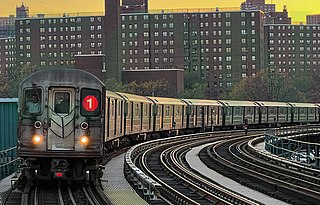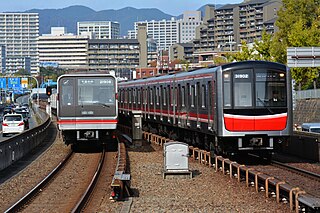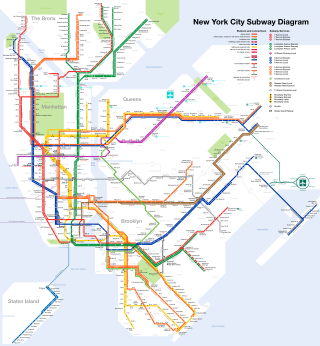
The New York City Subway is a rapid transit system in the New York City boroughs of Manhattan, Brooklyn, Queens, and the Bronx. It is owned by the government of New York City and leased to the New York City Transit Authority, an affiliate agency of the state-run Metropolitan Transportation Authority (MTA). Opened on October 27, 1904, the New York City Subway is one of the world's oldest public transit systems, one of the most-used, and the one with the most stations, with 472 stations in operation.

The Osaka Metro is a major rapid transit system in the Osaka Metropolitan Area of Japan, operated by the Osaka Metro Company, Ltd. It serves the city of Osaka and the adjacent municipalities of Higashiosaka, Kadoma, Moriguchi, Sakai, Suita, and Yao. Osaka Metro forms an integral part of the extensive mass transit system of Greater Osaka, having 123 out of the 1,108 rail stations (2007) in the Osaka-Kobe-Kyoto region. In 2010, the greater Osaka region had 13 million rail passengers daily of which the Osaka Municipal Subway accounted for 2.29 million.

The Kyoto Municipal Subway, also known as Kyoto City Subway, is the rapid transit network in the city of Kyoto, Japan. Operated by the Kyoto Municipal Transportation Bureau, it has two lines.
The Second Avenue Subway is a New York City Subway line that runs under Second Avenue on the East Side of Manhattan. The first phase of this new line, with three new stations on Manhattan's Upper East Side, opened on January 1, 2017. The full Second Avenue Line will be built in three more phases to eventually connect Harlem–125th Street in East Harlem to Hanover Square in Lower Manhattan. The proposed full line would be 8.5 miles (13.7 km) and 16 stations long, serve a projected 560,000 daily riders, and cost more than $17 billion.

The Toronto subway is a rapid transit system serving Toronto and the neighbouring city of Vaughan in Ontario, Canada, operated by the Toronto Transit Commission (TTC). As of September 2023, the subway system is a rail network consisting of three heavy-capacity rail lines operating predominantly underground. As of December 2022, three new lines are under construction: two light rail lines and one subway line.

The Beijing Subway is the rapid transit system of Beijing Municipality that consists of 27 lines including 22 rapid transit lines, two airport rail links, one maglev line and two light rail tram lines, and 490 stations. The rail network extends 836 km (519 mi) across 12 urban and suburban districts of Beijing and into one district of Langfang in neighboring Hebei province. In December 2023, the Beijing Subway became the world's longest metro system by route length, surpassing the Shanghai Metro. With 3.8484 billion trips delivered in 2018 and single-day ridership record of 13.7538 million set on July 12, 2019, the Beijing Subway was the world's busiest metro system in the years immediately prior to the outbreak of the COVID-19 pandemic.

Line 2 Bloor–Danforth is a subway line in the Toronto subway system, operated by the Toronto Transit Commission (TTC). It has 31 stations and is 26.2 kilometres (16.3 mi) in length. It opened on February 26, 1966, and extensions at both ends were completed in 1968 and again in 1980.

Line 1 Yonge–University is a rapid transit line of the Toronto subway. It serves Toronto and the neighbouring city of Vaughan in Ontario, Canada. It is operated by the Toronto Transit Commission, has 38 stations and is 38.4 km (23.9 mi) in length, making it the longest line on the subway system. It opened as the "Yonge subway" in 1954 as Canada's first underground passenger rail line and was extended multiple times between 1963 and 2017. As of 2010, Line 1 was the busiest rapid transit line in Canada, and one of the busiest lines in North America. In 2022, it averaged over 670,000 riders per weekday.

The Times Square–42nd Street station is a major New York City Subway station complex located under Times Square, at the intersection of 42nd Street, Seventh Avenue, and Broadway, in Midtown Manhattan. The complex allows free transfers between the IRT 42nd Street Shuttle, the BMT Broadway Line, the IRT Broadway–Seventh Avenue Line and the IRT Flushing Line, as well as to the IND Eighth Avenue Line a block west at 42nd Street–Port Authority Bus Terminal. The complex is served by the 1, 2, 3, 7, N and Q trains at all times, the W train during weekdays; the R and 42nd Street Shuttle (S) trains at all times except late nights; and <7> trains during rush hours in the peak direction. A free passageway from the shuttle platform to the 42nd Street–Bryant Park/Fifth Avenue station, served by the 7, <7>, B, D, F, <F>, and M trains, is open during the day from 6 a.m. to 12 a.m.

The 81st Street–Museum of Natural History station is a local station on the IND Eighth Avenue Line of the New York City Subway. It is served by the B on weekdays, the C train at all times except nights, and the A train during late nights only.

The New York City Subway is a rapid transit system that serves four of the five boroughs of New York City, New York: the Bronx, Brooklyn, Manhattan, and Queens. Its operator is the New York City Transit Authority, which is itself controlled by the Metropolitan Transportation Authority of New York. In 2015, an average of 5.65 million passengers used the system daily, making it the busiest rapid transit system in the United States and the 11th busiest in the world.

The Grand Central–42nd Street station is a major station complex of the New York City Subway. Located in Midtown Manhattan at 42nd Street between Madison and Lexington Avenues, it serves trains on the IRT Lexington Avenue Line, the IRT Flushing Line and the 42nd Street Shuttle. The complex is served by the 4, 6, and 7 trains at all times; the 5 and 42nd Street Shuttle (S) trains at all times except late nights; the <6> train during weekdays in the peak direction; and the <7> train during rush hours and early evenings in the peak direction.

The 50th Street station is a local station on the IRT Broadway–Seventh Avenue Line of the New York City Subway. Located at the intersection of 50th Street and Broadway in the Theater District of Manhattan, it is served by the 1 train at all times and by the 2 train during late nights.

The 59th Street–Columbus Circle station is a New York City Subway station complex shared by the IRT Broadway–Seventh Avenue Line and the IND Eighth Avenue Line. It is located at Columbus Circle in Manhattan, where 59th Street, Broadway and Eighth Avenue intersect, and serves Central Park, the Upper West Side, Hell's Kitchen, and Midtown Manhattan. The station is served by the 1, A, and D trains at all times; the C train at all times except late nights; the B train during weekdays until 11:00 p.m.; and the 2 train during late nights.

The Fulton Street station is a major New York City Subway station complex in Lower Manhattan. It consists of four linked stations on the IND Eighth Avenue Line, the IRT Lexington Avenue Line, the BMT Nassau Street Line and the IRT Broadway–Seventh Avenue Line. The complex is served by the 2, 4, A, and J trains at all times. The 3, 5, and C trains stop here at all times except late nights, and the Z stops during rush hours in the peak direction.

The Metro Manila Subway, formerly known as the Mega Manila Subway (MMS) is an under-construction underground rapid transit line in Metro Manila, Philippines. The 33-kilometer (21 mi) line, which will run north–south between Valenzuela, Quezon City, Pasig, Taguig, Parañaque and Pasay, consists of 17 stations between the East Valenzuela and Bicutan stations. It will become the country's second direct airport rail link after the North–South Commuter Railway, with a branch line to Ninoy Aquino International Airport.

The physical accessibility of the Metropolitan Transportation Authority (MTA)'s public transit network, serving the New York metropolitan area, is incomplete. Although all buses are wheelchair-accessible in compliance with the Americans with Disabilities Act of 1990 (ADA), much of the MTA's rail system was built before wheelchair access was a requirement under the ADA. This includes the MTA's rapid transit systems, the New York City Subway and Staten Island Railway, and its commuter rail services, the Long Island Rail Road (LIRR) and Metro-North Railroad. Consequently, most stations were not designed to be accessible to people with disabilities, and many MTA facilities lack accessible announcements, signs, tactile components, and other features.


















